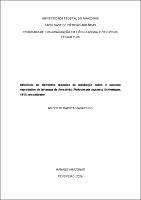| ???jsp.display-item.social.title??? |


|
Please use this identifier to cite or link to this item:
https://tede.ufam.edu.br/handle/tede/10202| ???metadata.dc.type???: | Dissertação |
| Title: | Influência de diferentes sistemas de incubação sobre o sucesso reprodutivo de tartaruga-da-Amazônia (Podocnemis expansa, Schweigger, 1812) em cativeiro |
| ???metadata.dc.creator???: | Viana Filho, Gilberto Batista  |
| ???metadata.dc.contributor.advisor1???: | Andrade, Paulo Cesar Machado |
| ???metadata.dc.contributor.referee1???: | Lima, Aldeniza Cardoso de |
| ???metadata.dc.contributor.referee2???: | Dairiki, Jony Koji |
| ???metadata.dc.description.resumo???: | Historicamente, muitas espécies de quelônios em diversas partes do mundo apresentam grande importância alimentar, econômica e cultural. Dentre as espécies amazônicas, a tartaruga-da-Amazônia (Podocnemis expansa) é a com maior potencial comercial, devido ao seu alto desempenho e aceitação pelo mercado consumidor. No entanto, a reprodução desses animais nos criadores comerciais legalizados vem ao longo dos anos apresentando problemas, com índices de eclosão baixos e poucos estudos abordando a eficiência reprodutiva em cativeiro. Neste trabalho objetivamos: avaliar a influência dos diferentes sistemas de incubação (natural, com transferência e artificial) sobre o sucesso reprodutivo da tartaruga-da-Amazônia (P. expansa) em cativeiro. Foram analisados os índices de eclodibilidade de ovos, razão sexual e desempenho de filhotes de tartarugas-da-Amazônia (Podocnemis expansa) incubados em ninho natural, chocadeira e incubadoras com temperaturas de 29ºC, 30ºC e 33ºC. O experimento foi conduzido, desde 2021, no criatório Bicho de Rio, no Iranduba, AM e no Laboratório de Animais Silvestres da UFAM (LAS). Em 2021 e 2023, foram monitoradas as praias dos tanques de reprodução, sendo registrados e marcados em cada ano, ninhos naturais (3), dos quais alguns foram transferidos (3) para chocadeira (praia artificial cercada) e outros para incubadoras com temperatura controlada (3). As temperaturas de incubação nos três sistemas foram monitoradas com dataloggers HOBO TidbiTv2© e a umidade/temperatura por termo-higrômetros. Foram analisadas as características de cada ninho, biometria dos ovos, taxa de eclosão e biometria dos filhotes. As taxas de eclosão médias foram: natural (33,1±36,7), chocadeira (43,3±32,6), incubadora de 29ºC (46,9±20,7), incubadora de 30ºC (51,7±28,6) e incubadora 33ºC (31,1±34,7). Entretanto, não houve diferença significativa entre tratamentos para as taxas de eclosão. Não ouve diferença na razão sexual, entre tratamentos, mas foi verificada uma tendência (R²=0,35), quanto mais altas as temperaturas, menor a quantidade de filhotes machos. Há correlação forte (R²=0,97) entre a temperatura (ºC) e os dias de incubação, quanto menores as temperaturas, maior o é período de incubação. Há uma tendência (R²=0,13) que quanto maior o tempo da incubação, menores são as taxas de eclosão. |
| Abstract: | Historically, many species of chelonians around the world have significant importance in terms of food, economy, and culture. Among the Amazonian species, the Giant South American River Turtle (Podocnemis expansa) holds the greatest commercial potential due to its high performance and acceptance in the consumer market. However, the reproduction of these animals in legal commercial breeding facilities has faced challenges over the years, with low hatching rates and limited studies addressing reproductive efficiency in captivity. This study aims to evaluate the influence of different incubation systems (natural, with transfer, and artificial) on the reproductive success of the Giant South American River Turtle (P. expansa) in captivity. The study analyzed egg hatchability rates, sex ratio, and the performance of Giant South American River Turtle hatchlings incubated in natural nests, incubators, and hatcheries with temperatures set at 29°C, 30°C, and 33°C. The experiment has been ongoing since 2021 at the Bicho de Rio breeding facility in Iranduba, AM, and the Wildlife Laboratory of UFAM (LAS). In 2021 and 2023, the reproduction tank beaches were monitored, and natural nests (3) were recorded and marked each year, some of which were transferred (3) to hatcheries (enclosed artificial beach) and others to incubators with controlled temperatures (3). Incubation temperatures in all three systems were monitored using HOBO TidbiTv2© data loggers, and humidity/temperature levels were recorded with thermohygrometers. The characteristics of each nest, egg biometrics, hatching rates, and hatchling biometrics were analyzed. The average hatching rates were as follows: natural (33.1±36.7), hatchery (43.3±32.6), 29°C incubator (46.9±20.7), 30°C incubator (51.7±28.6), and 33°C incubator (31.1±34.7). However, there was no significant difference between treatments for hatching rates. There was no difference in sex ratio between treatments, but a trend was observed (R²=0.35), indicating that higher temperatures resulted in fewer male hatchlings. There is a strong correlation (R²=0.97) between temperature (°C) and incubation days; lower temperatures prolong the incubation period. There is also a trend (R²=0.13) indicating that longer incubation times lead to lower hatching rates. |
| Keywords: | . . . |
| ???metadata.dc.subject.cnpq???: | CIENCIAS BIOLOGICAS: ZOOLOGIA |
| ???metadata.dc.subject.user???: | Criação Manejo Ovos Quelônios Reprodução |
| Language: | por |
| ???metadata.dc.publisher.country???: | Brasil |
| Publisher: | Universidade Federal do Amazonas |
| ???metadata.dc.publisher.initials???: | UFAM |
| ???metadata.dc.publisher.department???: | Faculdade de Ciências Agrárias |
| ???metadata.dc.publisher.program???: | Programa de Pós-Graduação em Ciência Animal e Recursos Pesqueiros |
| Citation: | VIANA FILHO, Gilberto Batista . Influência de diferentes sistemas de incubação sobre o sucesso reprodutivo de tartaruga-da-Amazônia (Podocnemis expansa, Schweigger, 1812) em cativeiro. 2024. 72 f. Dissertação (Mestrado em Ciência Animal e Recursos Pesqueiros) - Universidade Federal do Amazonas, Manaus, 2024. |
| ???metadata.dc.rights???: | Acesso Aberto |
| ???metadata.dc.rights.uri???: | https://creativecommons.org/licenses/by-nc-nd/4.0/ |
| URI: | https://tede.ufam.edu.br/handle/tede/10202 |
| Issue Date: | 21-Feb-2024 |
| Appears in Collections: | Mestrado em Ciência Animal e Recursos Pesqueiros |
Files in This Item:
| File | Description | Size | Format | |
|---|---|---|---|---|
| DISS_GilbertoVianaFilho_PPGCARP.pdf | 4.42 MB | Adobe PDF |  Download/Open Preview |
Items in DSpace are protected by copyright, with all rights reserved, unless otherwise indicated.




